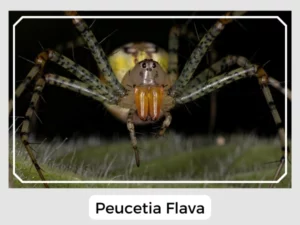Peucetia spiders belong to the lynx spider family and can be found all over the world. Some have special places they call home. For example, Peucetia longipalpis lives in the USA and parts of the Caribbean. Meanwhile, Peucetia viridana can only be found in Myanmar and India. Let’s learn some cool facts about these unique spiders.

Eggs are deposited in a safe sac that female spiders make with silk.
Spiderlings tend to leave after hatching. Some of them might go through the molting phase.
They do not build webs but spin silk to cover their egg sac and line their burrows.
Yes, Peucetia Spiders have venom. They use it to catch the little bugs they eat. But for humans, their venom isn’t super strong.
Peucetia Spiders can bite, but they’re usually calm critters. They mostly stay out of trouble and will only bite if they feel very scared.
Peucetia spiders camouflage with vivid green bodies, showcasing adaptability and playing a key ecological role in plants.
Natural Predator: Peucetia spiders have many predators like birds, bigger insects, and some reptiles. Their bright colors help them hide in green plants but can also attract danger. Some wasps lay eggs on or inside these spiders, and the hatching larvae eat the spider.
Prey-Predator Dynamics: These spiders are good hunters too. They mostly eat insects and sometimes lizards. Their long legs make them fast and agile, helping them catch prey quickly. Their green color helps them hide from threats and surprise their prey.
Relationship with Humans: Peucetia spiders don’t usually bother humans. Their venom isn’t harmful to us, but they might bite if threatened, causing temporary pain. People mainly interact with these spiders by admiring their beauty and importance to nature.
| Distribution | The spiders belonging to the Peucetia genus can be found distributed across various regions throughout the year. |
| Habitat | The primary habitat of the Peucetia spiders is among green plants. |
| Diet | Spiders of the Peucetia genus have a varied diet, which primarily consists of insects. Moreover, these spiders have occasionally been observed preying on small lizards. |
| Lifespan | The lifespan of the Peucetia spiders averages around 1 year. |
In conclusion, understanding and appreciating the Peucetia genus goes beyond just knowing their names or their physical characteristics. It’s about recognizing their ecological importance, the delicate balance of their prey-predator dynamics, and their benign relationship with humans.
Peucetia spiders belong to the lynx spider family and can be found all over the world. Some have special places they call home. For example, Peucetia longipalpis lives in the USA and parts of the Caribbean. Meanwhile, Peucetia viridana can only be found in Myanmar and India. Let’s learn some cool facts about these unique spiders.

Eggs are deposited in a safe sac that female spiders make with silk.
Spiderlings tend to leave after hatching. Some of them might go through the molting phase.
They do not build webs but spin silk to cover their egg sac and line their burrows.
Yes, Peucetia Spiders have venom. They use it to catch the little bugs they eat. But for humans, their venom isn’t super strong.
Peucetia Spiders can bite, but they’re usually calm critters. They mostly stay out of trouble and will only bite if they feel very scared.
Peucetia spiders camouflage with vivid green bodies, showcasing adaptability and playing a key ecological role in plants.
Natural Predator: Peucetia spiders have many predators like birds, bigger insects, and some reptiles. Their bright colors help them hide in green plants but can also attract danger. Some wasps lay eggs on or inside these spiders, and the hatching larvae eat the spider.
Prey-Predator Dynamics: These spiders are good hunters too. They mostly eat insects and sometimes lizards. Their long legs make them fast and agile, helping them catch prey quickly. Their green color helps them hide from threats and surprise their prey.
Relationship with Humans: Peucetia spiders don’t usually bother humans. Their venom isn’t harmful to us, but they might bite if threatened, causing temporary pain. People mainly interact with these spiders by admiring their beauty and importance to nature.
| Distribution | The spiders belonging to the Peucetia genus can be found distributed across various regions throughout the year. |
| Habitat | The primary habitat of the Peucetia spiders is among green plants. |
| Diet | Spiders of the Peucetia genus have a varied diet, which primarily consists of insects. Moreover, these spiders have occasionally been observed preying on small lizards. |
| Lifespan | The lifespan of the Peucetia spiders averages around 1 year. |
In conclusion, understanding and appreciating the Peucetia genus goes beyond just knowing their names or their physical characteristics. It’s about recognizing their ecological importance, the delicate balance of their prey-predator dynamics, and their benign relationship with humans.